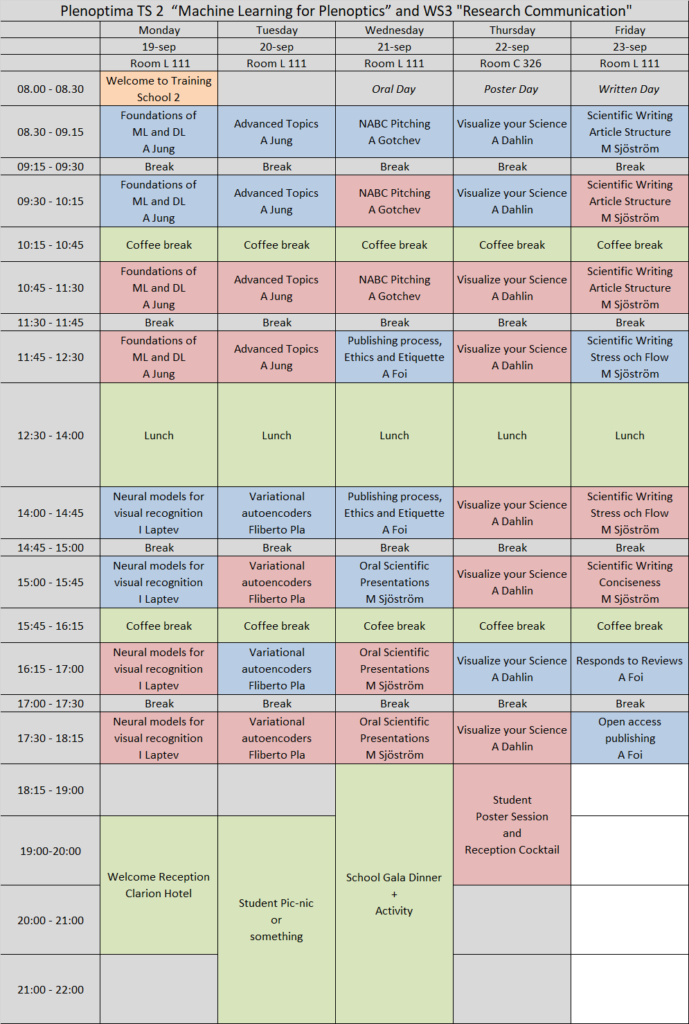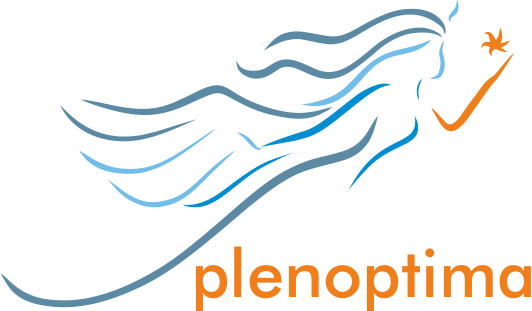
The programme of Training school 2 and Workshop 3 is given in the schedule below.
Read more about the lectures and the preparatory readings further down.

Monday
Foundations of Machine Learning and Deep Learning
Data, model, loss, empirical risk, ERM, regression methods, Class loss, Linear classifiers, decision trees, Model validation and selection, Model diagnosis.
Preparatory readings
Excercises will be carried out in Python. Install for instance JupyterLab before the excercise.
Neural models for visual recognition
Automatic recognition of images and videos has been skyrocketing in the last decade. While new methods enable large gains in accuracy, they also provide a common and convenient framework for processing visual, language and sound data. This lecture will cover recent models, methods and common tasks of visual recognition. In particular, we will cover convolutional neural networks for image classification and object detection. We will also introduce Transformer architectures and describe their advantages for joint image-language tasks. We will finally look into key practical issues of deep models and discuss self-supervised learning strategies that eliminate the need of prohibitive large-scale data labeling.
Excercise: We will do a practical session in Google Colab. To get started, download the Python notebook below and then upload it to your Colab session once you open https://colab.research.google.com/
https://www.di.ens.fr/~laptev/share/plenoptima22/plenoptima22_cv_practical.ipynb
Tuesday
Advanced Topics
Regularization, Semi-supervised learning, Multitask Learning, Transfer learning, Hard clustering/k-means, Soft clustering/GMM, PCA.
Preparatory readings
- Wagner, N., Beuttenmueller, F., Norlin, N. et al. Deep learning-enhanced light-field imaging with continuous validation. Nat Methods 18, 557–563 (2021).
Exercises will be carried out in Python. Install for instance JupyterLab before the exercise.
Variational Autoencoders
- Auto-encoders:
- Definition and structure,
- Linear vs non-linear embedding.
- Deep and convolutional autoencoders
- Generative NNs. Modelling uncertainty:
- Hidden random variable model of observed data.
- Probabilistic inference:
- Variational inference.
- From deterministic to variational auto-encoders:
- Latent space distribution
- The re-parametrization trick.
Preparatory readings
Exercises
- Practical applications in imaging.
- Practical examples and exercises (Keras + Google-Colab) found in TAU Moodle
- Note: For the practical exercises you must use GoogleColab (Google account necessary).
Wednesday
NABC Pitching
I will spend the first 45 min overviewing the NABC pitching method. Then we will be practicing pitching, giving and receiving feedback, and iterating for improving the value proposition.
Preparatory readings
- A brief summary of NABC
- IMPORTANT! Select an article in progress for which you are the first author. Alternatively, it may be a previously published article.
- Read your article
- Think about how you could pitch your work.
Publishing process; Ethics and Etiquette : “Things you should know before submitting your next paper”
The lecture is particularly addressed to new authors with little experience about the publication workflow and principles, and it is focused on the dos and don’ts for successfully publishing a technical paper. It offers an overview of the peer-review process and discusses the ethics and etiquette standards that authors are expected to uphold and that reviewers and editors are looking for. The lecture is based on material used at IEEE training events for authors and volunteers, supplemented by additional material by the Committee on Publication Ethics (COPE); it discusses general principles followed by various publishers and communities in science and engineering.
Topics include: choice of the publication venue, framing of the contribution with respect to prior art and literature, authorship and acknowledgment, fair reporting of own and others’ results, appropriate disclosure and referencing to own previous work, appropriate description and citing of prior work, plagiarism, duplicate submissions, inappropriate replication, and bibliometric manipulation, author’s responsibilities.
Oral Scientific Presentations
- Goal of your presentation – who is the audience?
- Design an oral presentation – what is your story?
- Your behaviour – how to interact with the audience?
Preparatory readings
- Browse through slides for the lecture and the exercises (found in TAU Moodle)
- IMPORTANT! Select an article in progress for which you are the first author. Alternatively, it may be a previously published article.
- Read your article
- Think about your main points of the article.
Exercises
- Design your presentation
- Oral skills and practice
Summary: Make your own check list
Thursday
Visualize Your Science
8.30-8.45 Introduction
8.45-9.15 Lecture onVisuals in Science
9.30-10.30 Lecture on Scientific posters
10.30-11.00 Excercise on first sketches of structure on a A4 paper
11.00-12.30 Exercise in groups of three; give each oher feedback on structure + sketching of A1/A0 poster.
14.00-16.00 Esercise continues. Feedback from WS leader.
16.15-16.45 Lecture Summary.
16.45-17.30 Demo: Digitalization of a poster.
17.45-18.15 Exercise: Finalizing posters adn feedback from WS leader.
Student Poster Session
Each workshop participant presents an NABC and her/his digital poster.
Friday
Scientific Writing
Structure of a scientific article, Structuring the contents, Binding sections together, Building paragraphs and sentences, Conciseness.
Preparatory readings
- Browse through slides for the lecture and the exercises (found in TAU Moodle)
- Sec 9.2 “Structure of an academic text” (and possibly also Sec 9.3 “Main text according to IMRaD”) in K Säfsten, M Gustavsson “Research Methodology”, Studentlitteratur, Sweden 2020
- “How To Structure Sentences”, summary by Elijs Dima (found in TAU Moodle)
- IMPORTANT! Select an article in progress for which you are the first author. Alternatively, it may be a previously published article.
- Read your article
- Think if re-structuring it would be beneficial.
Excercises
- Practical structuring of your article – making it hold together, starting from your “story”.
- Building Paragraphs and Sentences – creating flow.
- Conciseness – Using the space and establishing focus.
- Summary: Make your own check list.
Responding to reviews and managing the revision process
It is extremely rare (though not impossible) that a manuscript submitted to a top-tier journal gets accepted “as is” after the review of the original submission. Most often the manuscript goes through an iterative process, where editors interact with authors and reviewers with the goal of revising the manuscript to make it suitable for publication in the journal. The lecture discusses the manuscript revision process, highlighting the editorial perspective and the typical mistakes that authors make. Participants will learn how to manage and execute a productive and efficient revision, ultimately maximizing the chances that the revised manuscript will get accepted, and in fewer iterations.
Open Access Publishing
The lecture discusses the main publishing models, including the leading variants of open access, as well as preprint/post-print policies, embargoes, and funding mandates. Furthermore, we discuss how the transition towards a universal “gold” open access model is impacting the economy and dynamics in scientific publishing.
